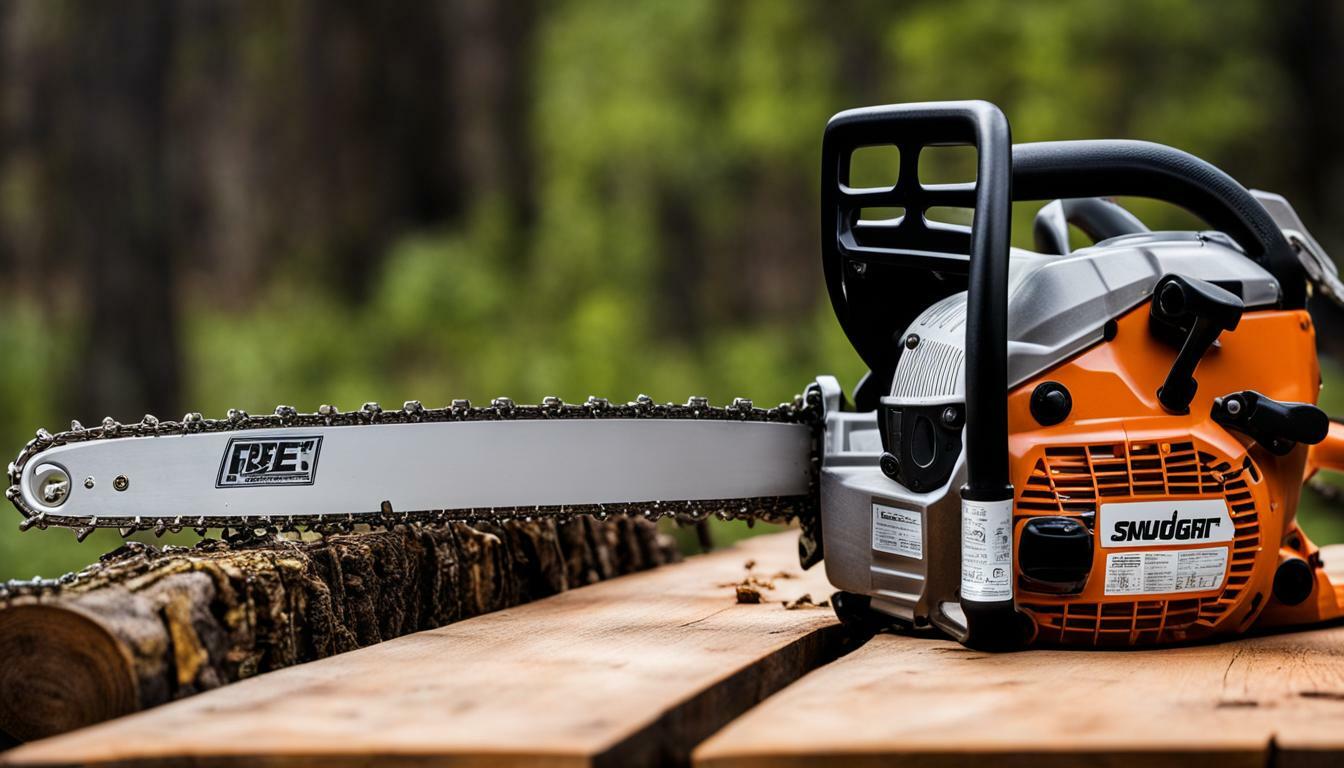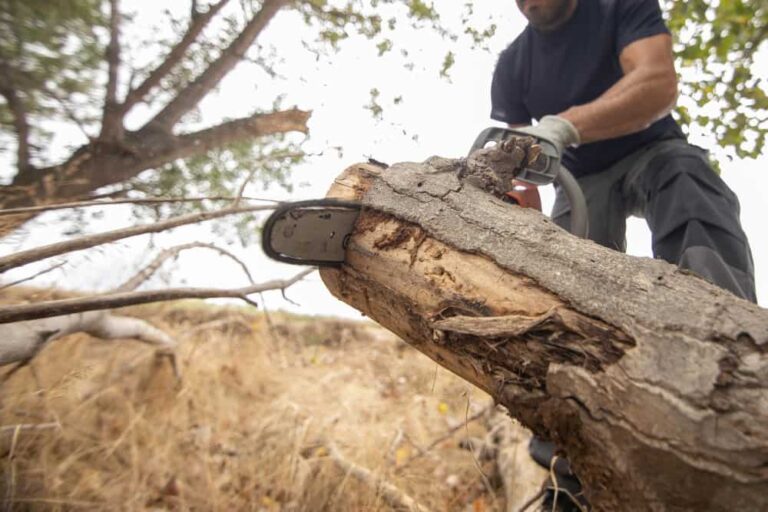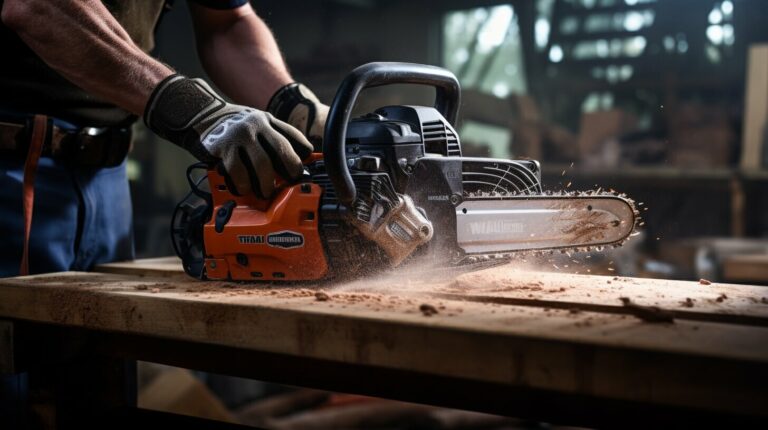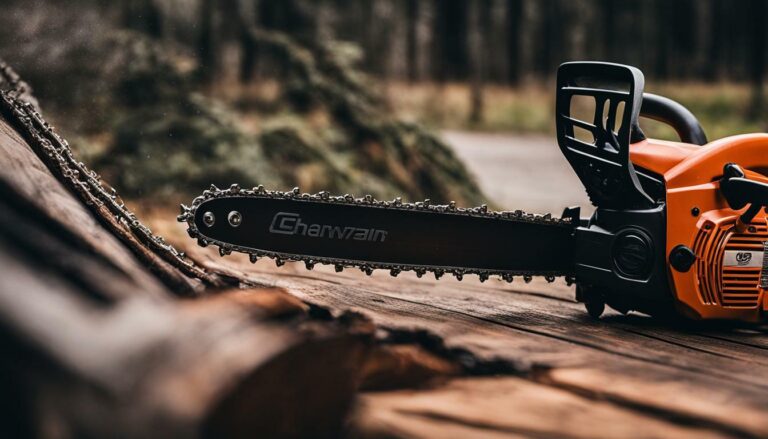How Tight Should a Chain Be on a Chainsaw? Understand Expert Opinion
When operating a chainsaw safely and efficiently, having the correct tension on your chainsaw chain is crucial. A chain that is too loose can damage both your chainsaw and yourself, while a chain that is too tight can cause excessive wear on the bar and engine, making your chainsaw less effective. This guide will provide you with all the information you need as to how tight should a chain be on a chainsaw.
Key Takeaways:
- Proper chain tension is essential for safe and efficient chainsaw operation.
- A chain that is too loose or too tight can cause damage to your chainsaw and create safety hazards.
- Regularly checking and adjusting your chainsaw chain’s tension is crucial for optimal performance and longevity.
- Following the step-by-step instructions in this guide will help you adjust your chainsaw chain’s tension to the correct tightness.
- Proper chain maintenance is important for optimal performance and longevity.
Understanding How tight should a chain be on a chainsaw
Before we dive into how tight a chainsaw chain should be, it’s important to understand chain tensioning. The proper tension is crucial for your chainsaw’s safe and effective operation. A too-loose chain can jump off the bar, while a too-tight chain can cause excessive wear on the components.
The proper tension will also ensure the chain is cutting at optimal performance. When a chain is too loose, it can reduce cutting efficiency and may even cause damage to the saw.
When adjusting your chainsaw chain tension, it’s important to follow the manufacturer’s recommendations for the proper tightness. The proper tightness will vary depending on the make and model of your chainsaw. You can find the recommended tightness in the owner’s manual or on the manufacturer’s website.
When adjusting the tension, it’s important to use caution and wear protective gear, such as gloves and eye protection. Never adjust the tension when the chainsaw is running, and always ensure the chainsaw is turned off before making any adjustments.
Some tips for successfully tensioning your chainsaw chain include checking the tension frequently, making small adjustments at a time, and ensuring that the bar and chain are clean and free of debris. Keeping your chainsaw’s chain at the proper tightness will ensure optimal performance and longevity of your saw.
How to Adjust Chain Tension on a Chainsaw
Adjusting the chain tension on your chainsaw is a simple process that can help ensure safe and efficient operation. Here are the steps to follow:
- Prepare your chainsaw for adjustment: Before making any adjustments, turn off your chainsaw and unplug it if it is corded. If it is gas-powered, make sure the engine is cool before proceeding.
- Loosen the chain: Use a chainsaw wrench to loosen the nuts on the guide bar side panel located near the chainsaw’s engine. Once the nuts are loose, use a flathead screwdriver to turn the chain tensioning screw counterclockwise to loosen the chain.
- Adjust the chain: While holding the chainsaw bar nose up, use your fingers to pull the chain down to check its tension. The chain should be tight against the guide bar, but still loose enough to be pulled around the bar. Use the screwdriver to turn the tensioning screw clockwise until the chain is adjusted to the proper tension, as specified in your chainsaw’s manual.
- Check the tension: Once you’ve adjusted the chain tension, tighten the nuts on the guide bar side panel and double-check the tension using your fingers. Make sure the chain is properly seated in the guide bar’s groove and adjust the tension again if necessary.
If you’re unsure about the how tight should a chain be on a chainsaw, consult your owner’s manual or contact the manufacturer for guidance.
It’s important to note that some chainsaw models may require additional tools or steps to adjust the chain tension, such as adjusting the carburetor. If you’re unsure how to adjust the carburetor on your chainsaw, consult the owner’s manual or seek professional assistance to avoid damaging your equipment.
Regular chain tension adjustments are essential to proper chainsaw maintenance and safety. Properly adjusted chainsaws cut more efficiently, reduce operator fatigue and wear on the chain and guide bar, and minimize the risk of kickback or other accidents. By keeping your chainsaw’s chain tension at optimal, you can enjoy safer, more efficient cutting for years to come.
Importance of Proper Chain Tension
Having the correct tension on your chainsaw chain is vital for safe and efficient operation. The correct tension ensures the chain runs smoothly and reduces the risk of accidents. Additionally, maintaining the proper tension will also help to extend the life of your chainsaw.
Correct chainsaw chain tension ensures optimal cutting performance, as well. If the chain is too loose, it will not cut effectively and will wear down the chainsaw’s components more quickly. On the other hand, if the chain is too tight, it will put too much pressure on the saw, making it difficult to cut and putting the operator at risk of injury.
When it comes to optimal chainsaw chain tightness, the ideal tension allows the chain to move smoothly along the bar with minimal sag. To achieve the ideal chainsaw chain tension, checking and adjusting it regularly is essential, especially if you are working with the saw for prolonged periods.
By maintaining the correct chainsaw chain tension, you can achieve optimal cutting performance, reduce wear on components, and enhance safety for the operator. Always refer to your chainsaw’s user manual for specific instructions on the correct tension, and routinely check the tension during use to ensure the chainsaw is operating safely and smoothly.
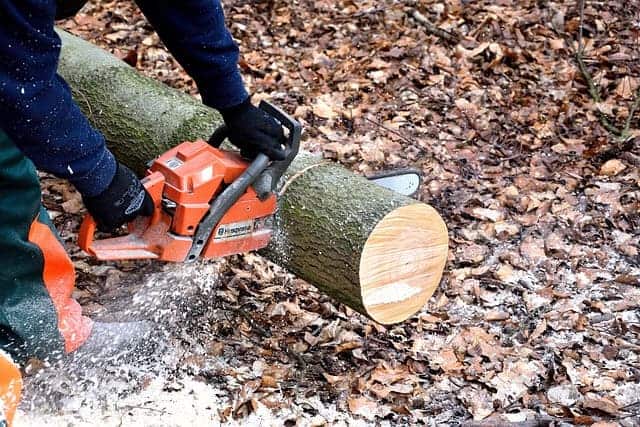
Tips for Chainsaw Chain Maintenance
Knowing how to correctly put a chain on a chainsaw is essential for optimal performance. First, loosen the tensioning screw so that the guide bar can move freely. Then, place the chain around the guide bar, ensuring that the teeth are facing in the correct direction (towards the chainsaw engine). Next, align the chain with the guide bar by pulling the nose of the guide bar upwards while tightening the tensioning screw. Finally, check the tension of the chain by pulling it away from the guide bar. You should be able to pull the chain about 1/8 to 1/4 of an inch away from the bar.
Always wear gloves when handling chainsaw chains, as they are sharp and can cause injury. It’s also crucial to keep the chain clean and lubricated. Clean your chain regularly by using a wire brush to remove any debris and wiping it down with a cloth. Keep the chain lubricated with chainsaw oil to prevent it from overheating and wearing out. It’s best to avoid using regular motor oil or other lubricants on your chainsaw chain, as they can damage the chain and reduce cutting performance.
Proper chainsaw chain maintenance also includes routinely inspecting the chain for any damage or wear. Look for any missing or broken teeth, as well as any signs of stretching or warping. If you notice any damage, replace the chain immediately to avoid any safety hazards or reduced cutting performance.
By following these chainsaw chain maintenance tips, you can ensure that your chainsaw is always performing at its best and that the chain is facing the right way for efficient cutting. Remember to wear protective gear and always handle your chainsaw with caution.
Conclusion
Now that you understand the importance of having the correct tension on your chainsaw chain, you can ensure safe and efficient operation of your equipment. Regularly checking and adjusting the chain tension can improve cutting performance, reduce wear on your chainsaw components, and enhance safety for you as the operator.
Remember to follow the tips in this guide when adjusting your chainsaw’s chain tension, whether you use manual or tool-assisted methods. Proper chain maintenance is also crucial for optimal chainsaw performance and longevity, and we’ve guided how to install a chain correctly and perform routine maintenance tasks.
Thank you for taking the time to read this guide on how tight should a chain be on a chainsaw. We hope the information provided has been valuable and will help you achieve the ideal chain tension for your chainsaw. Happy cutting!
FAQ
How tight should a chainsaw chain be?
The chainsaw chain should have the correct tension to ensure safe and efficient operation. It should be snug against the guide bar, but still able to move freely by hand. Avoid overtightening, as it can cause damage to the chain and the chainsaw.
Why is chain tensioning important?
Maintaining the correct tension in your chainsaw chain is crucial for optimal cutting performance and safety. If the chain is too loose, it may jump off the guide bar or fail to cut properly. If it’s too tight, it can put unnecessary strain on the chainsaw’s components and increase the risk of accidents.
How do I adjust the chain tension on a chainsaw?
To adjust the chain tension, you can either use the chain tensioning tool that came with your chainsaw or do it manually. With the tool, simply follow the manufacturer’s instructions. For manual adjustment, loosen the guide bar nuts, then turn the tensioning screw until the chain is properly tensioned. Remember to tighten the guide bar nuts once the tension is correct.
What are the benefits of proper chain tension?
Proper chain tension ensures smooth and efficient cutting, reducing wear on the chainsaw’s components and extending their lifespan. It also enhances safety by reducing the risk of chain derailment and kickback, which can be dangerous for the operator.
How do I install a chainsaw chain correctly?
When installing a chainsaw chain, ensure it is facing correctly. The teeth should be pointing towards the front of the chainsaw, and the cutting edges should meet away from you. Please follow the manufacturer’s instructions for your specific chainsaw model to ensure it’s properly installed.
Any tips for chainsaw chain maintenance?
Regular chain maintenance is essential for optimal performance. Keep the chain clean and lubricated, and regularly inspect it for damage or signs of wear. Please carefully sharpen the chain when necessary to maintain cutting efficiency. Periodically check and adjust the chain tension to remain within the recommended range.
Source:-
